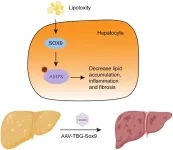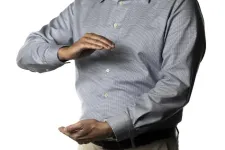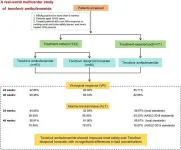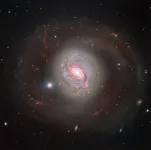(Press-News.org) Individuals with sickle cell disease – a chronic illness where misshapen, sticky blood cells clump together, reducing oxygen delivery to organs – are at a higher risk for stroke and resulting cognitive disability. But even in the absence of stroke, many such patients struggle with remembering, focusing, learning and problem solving, among other cognitive problems, with many facing challenges in school and in the workplace.
Now a multidisciplinary team of researchers and physicians at Washington University School of Medicine in St. Louis has published a study that helps explain how the illness might affect cognitive performance in sickle cell patients without a history of stroke. The researchers found such participants had brains that appeared older than expected for their age. Individuals experiencing economic deprivation, who struggle to meet basic needs, even in the absence of sickle cell disease, had more-aged appearing brains, the team also found.
The study was published January 17 in JAMA Network Open.
“Our study explains how a chronic illness and low socioeconomic status can cause cognitive problems,” said Andria Ford, MD, a professor of neurology and chief of the section of stroke and cerebrovascular diseases at WashU Medicine and corresponding author on the study. “We found that such factors could impact brain development and/or aging, which ultimately affects the mental processes involved in thinking, remembering and problem solving, among others. Understanding the influence that sickle cell disease and economic deprivation have on brain structure may lead to treatments and preventive measures that potentially could preserve cognitive function.”
More than 200 young, Black adults with and without sickle cell disease, living in St. Louis and the surrounding region in eastern Missouri and southwestern Illinois, participated in brain MRI scans and cognitive tests. The researchers – including Yasheng Chen, DSc, an associate professor of neurology at WashU Medicine and senior author on the study – calculated each person’s brain age using a brain-age prediction tool that was developed using MRI brain scans from a diverse group of more than 14,000 healthy people of known ages. The estimated brain age was compared with the individual’s actual age.
The researchers found that participants with sickle cell disease had brains that appeared an average of 14 years older than their actual age. Sickle cell participants with older-looking brains also scored lower on cognitive tests.
The study also found that socioeconomic status correlates with brain age. On average, a seven-year gap was found between the brain age and the participants’ actual age in healthy individuals experiencing poverty. The more severe the economic deprivation, the older the brains of such study subjects appeared.
Healthy brains shrink as people age, while premature shrinking is characteristic of neurological illnesses such as Alzheimer’s disease. But a smaller brain that appears older can also result from stunted growth early in life. Sickle cell disease is congenital, chronically depriving the developing brain of oxygen and possibly affecting its growth from birth. Also, children exposed to long-term economic deprivation and poverty experience cognitive challenges that affect their academic performance, Ford explained.
As a part of the same study, the researchers are again performing cognitive tests and scanning the brains of the same healthy and sickle cell participants three years after their first scan to investigate if the older-looking brains aged prematurely, or if their development was stunted.
“A single brain scan helps measure the participants’ brain age only in that moment,” said Ford, who treats patients at Barnes-Jewish Hospital. “But multiple time points can help us understand if the brain is stable, initially capturing differences that were present since childhood, or prematurely aging and able to predict the trajectory of someone’s cognitive decline. Identifying who is at greatest risk for future cognitive disability with a single MRI scan can be a powerful tool for helping patients with neurological conditions.”
END
Brains of people with sickle cell disease appear older
Study also finds socioeconomic status linked to brain health in adults
2025-01-17
ELSE PRESS RELEASES FROM THIS DATE:
Elena Belova and Yevgeny Raitses recognized for groundbreaking plasma physics research
2025-01-17
The diversity of plasma research at the U.S. Department of Energy’s (DOE) Princeton Plasma Physics Laboratory (PPPL) was readily apparent when the PPPL 2024 Distinguished Research Fellows were recently announced. Elena Belova and Yevgeny Raitses were awarded the honor at the Lab’s annual State of the Laboratory event. Belova, a theoretical physicist, won for her work developing highly complex simulations of plasmas in different fusion experiments. Raitses, a managing principal research physicist, was honored for his experimental work on ...
SOX9 overexpression ameliorates metabolic dysfunction-associated steatohepatitis through activation of the AMPK pathway
2025-01-17
Background and Aims
The transcription factor sex-determining region Y-related high-mobility group-box gene 9 (SOX9) plays a critical role in organ development. Although SOX9 has been implicated in regulating lipid metabolism in vitro, its specific role in metabolic dysfunction-associated steatohepatitis (MASH) remains poorly understood. This study aimed to investigate the role of SOX9 in MASH pathogenesis and explored the underlying mechanisms.
Methods
MASH models were established using mice fed either a methionine- and choline-deficient (MCD) diet or a high-fat, high-fructose diet. To evaluate the effects of SOX9, hepatocyte-specific SOX9 deletion or overexpression was performed. ...
Florescent probes illuminate cholesterol and Alzheimer’s research
2025-01-17
The search for answers to Alzheimer’s disease and other neurodegenerative disorders remains one of the most pressing goals in brain research. Maciej J. Stawikowski, Ph.D., an assistant professor of chemistry and biochemistry at Florida Atlantic University’s Charles E. Schmidt College of Science, believes the key may lie in understanding how cholesterol and other lipids move through cells and affect their communication.
“It’s well known that lipids and Alzheimer’s are linked,” said Stawikowski, a member of the FAU Stiles-Nicholson Brain Institute. “Lipid imbalance may ...
Qigong significantly decreases chronic low back pain in US military veterans
2025-01-17
Chronic pain is widespread in the United States, particularly among military veterans, affecting between 40 to 70% of this population and serving as a leading cause of disability. Veterans experience chronic pain more often than civilians, with back pain being the most common. Up to 75% of older veterans report chronic pain, while younger veterans and those from recent conflicts face more severe pain.
Chronic low back pain in veterans affects not only physical health but also social and occupational functioning, often leading to job ...
New insights into pancreatic disease and diabetes
2025-01-17
Cystic fibrosis (CF) is a life-threatening genetic disease affecting multiple organ systems, with pancreatic dysfunction representing a critical and often overlooked complication. A groundbreaking study published in eGastroenterology introduces young rabbits with CF as a novel and accessible model to study CF-related pancreatic endocrine pathology. This model offers an unprecedented opportunity to deepen our understanding of CF-related diabetes (CFRD), a condition affecting up to 50% of adults with CF.
CF is caused by mutations in the CF transmembrane conductance regulator (CFTR) gene, ...
Effectiveness and safety of tenofovir amibufenamide in the treatment of chronic hepatitis B: A real-world, multicenter study
2025-01-17
Background and Aims
Chronic hepatitis B (CHB) remains a significant global health challenge, and effective antiviral therapies are essential for long-term management. This study aimed to evaluate the real-world effectiveness and safety of tenofovir amibufenamide (TMF) in a cohort of patients with chronic hepatitis B (CHB).
Methods
In this multicenter, prospective, real-world cohort study, 194 CHB patients were recruited from four hospitals between August 2021 and August 2022. Patients were divided into treatment-naïve (TN, n = 123) and ...
Higher costs limit attendance for life changing cardiac rehab
2025-01-17
Despite the success cardiac rehabilitation has shown at reducing heart-related deaths and hospital readmissions, higher out-of-pocket costs may prevent patients from participating in the program, a Michigan Medicine study suggests.
In a national study of over 40,000 people with Medicare and commercial insurance, 81.6% of patients did not have to pay for their initial cardiac rehabilitation session.
The medically supervised program lasts up to 36 sessions, which are often recommended for patients recovering from many conditions and procedures.
Among ...
Over 500 patients receive diagnosis through genetic reanalysis
2025-01-17
European consortium for Solving the Unsolved Rare Diseases demonstrates the significance of international collaboration to address the unmet medical needs on rare diseases’ diagnosis
More than 500 European patients with unknown conditions have received a diagnosis through new genetic research. This includes patients with rare neurological disorders, severe intellectual disabilities, muscle diseases, and hereditary gastrointestinal cancer. These diagnoses were achieved through extensive European collaboration, led by researchers from the University of Tübingen, Radboud university medical center, and the National Center ...
Brain changes in Huntington’s disease decades before diagnosis will guide future prevention trials
2025-01-17
Subtle changes in the brain, detectable through advanced imaging, blood and spinal fluid analysis, happen approximately twenty years before a clinical motor diagnosis in people with Huntington’s disease, finds a new study led by UCL researchers.
The research, published in Nature Medicine, was in collaboration with experts at the Universities of Glasgow, Gothenburg, Iowa, and Cambridge.
The team found that although functions such as movement, thinking or behaviour remained normal for a long time before the onset of symptoms in Huntington’s disease, subtle changes to the brain were taking place up to two decades earlier.
These findings pave the way for ...
U of A astronomers capture unprecedented view of supermassive black hole in action
2025-01-17
Active galactic nuclei are supermassive black holes at the center of certain galaxies. As matter falls into these black holes, enormous amounts of energy are released, making active galactic nuclei, or AGN, one of the most energetic phenomena that can be observed in space. University of Arizona astronomers have now produced the highest resolution direct images ever taken of an AGN in the infrared, using the Large Binocular Telescope Interferometer.
Researchers from the Max Planck Institute for Astronomy in Germany were also involved in the study. The findings are published in the journal Nature Astronomy.
"The ...
LAST 30 PRESS RELEASES:
Interaction of climate change and human activity and its impact on plant diversity in Qinghai-Tibet plateau
From addressing uncertainty to national strategy: an interpretation of Professor Lim Siong Guan’s views
Clinical trials on AI language model use in digestive healthcare
Scientists improve robotic visual–inertial trajectory localization accuracy using cross-modal interaction and selection techniques
Correlation between cancer cachexia and immune-related adverse events in HCC
Human adipose tissue: a new source for functional organoids
Metro lines double as freight highways during off-peak hours, Beijing study shows
Biomedical functions and applications of nanomaterials in tumor diagnosis and treatment: perspectives from ophthalmic oncology
3D imaging unveils how passivation improves perovskite solar cell performance
Enriching framework Al sites in 8-membered rings of Cu-SSZ-39 zeolite to enhance low-temperature ammonia selective catalytic reduction performance
AI-powered RNA drug development: a new frontier in therapeutics
Decoupling the HOR enhancement on PtRu: Dynamically matching interfacial water to reaction coordinates
Sulfur isn’t poisonous when it synergistically acts with phosphine in olefins hydroformylation
URI researchers uncover molecular mechanisms behind speciation in corals
Chitin based carbon aerogel offers a cleaner way to store thermal energy
Tracing hidden sources of nitrate pollution in rapidly changing rural urban landscapes
Viruses on plastic pollution may quietly accelerate the spread of antibiotic resistance
Three UH Rainbow Babies & Children’s faculty elected to prestigious American Pediatric Society
Tunnel resilience models unveiled to aid post-earthquake recovery
Satellite communication systems: the future of 5G/6G connectivity
Space computing power networks: a new frontier for satellite technologies
Experiments advance potential of protein that makes hydrogen sulfide as a therapeutic target for Alzheimer’s disease
Examining private equity’s role in fertility care
Current Molecular Pharmacology achieves a landmark: real-time CiteScore advances to 7.2
Skeletal muscle epigenetic clocks developed using postmortem tissue from an Asian population
Estimating unemployment rates with social media data
Climate policies can backfire by eroding “green” values, study finds
Too much screen time too soon? A*STAR study links infant screen exposure to brain changes and teen anxiety
Global psychiatry mourns Professor Dan Stein, visionary who transformed mental health science across Africa and beyond
KIST develops eco-friendly palladium recovery technology to safeguard resource security
[Press-News.org] Brains of people with sickle cell disease appear olderStudy also finds socioeconomic status linked to brain health in adults







